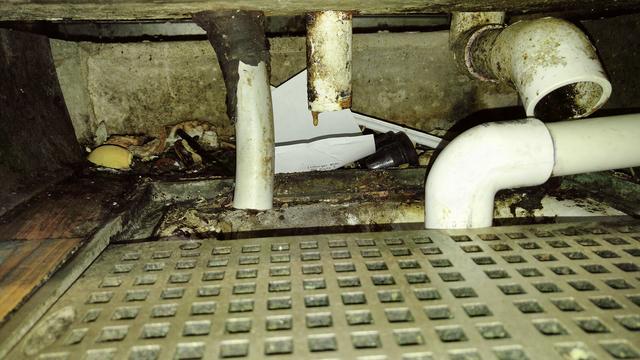Yuck! Poor sanitation in Roselle, NJ restaurant could lead to bugs.
Challenge
I was dispatched to a Cowleys commercial account, a restaurant in Roselle, NJ, in Union County. I’m a student of New Jersey history and Roselle has the unique honor of being the first village in the world to be lighted by Thomas Edison’s incandescent light bulb, proving that a town could be lighted by electricity from a single generating station!
But back to bugs. This restaurant was experiencing a noticeable increase in small flies and cockroach activity. Whenever I am dealing with an insect infestation in a restaurant, I always go back to basics. Insects are among the most primitive creatures on the planet whose resiliency has allowed them to survive since time immemorial. Their needs are simple. They require only food, water, and harborage to survive, thrive, and reproduce successive generations at astronomical rates. Eliminating these basic requirements of insect survival and making the environment inhospitable for them will go a long way in reducing, and eventually eliminating, indoor insect populations.
For a pest control technician, the only way to conduct a proper and thorough inspection is by getting up close and personal with their harborage and breeding areas. You have to know where they are in order to effectively deal with the problem. I knew I’d be bending and crawling to get to the level of the insects and find all of the signs of insect activity, so I put on my knee pads and grabbed my flashlight to do some serious inspecting. While down on the floor and looking underneath the kitchen appliances, I found breeding areas for small flies in the dirty floor drain, and there were cracked and broken tiles providing the perfect breeding grounds for cockroaches. Unfortunately, as is often the case with insect infestations in commercial kitchens, there were pretty serious sanitation deficiencies that led to the problems. To be sure, spotless kitchens can wind up with infestations (often because of hidden hitchhiking bugs in food deliveries), but usually, the restaurants that have insect problems are those that are lax in sanitation and hygiene protocols.
Solution
A picture is worth a thousand words, and with these infestations, I find it worthwhile to take pictures to visually document the deficiencies. It’s a lot more powerful and produces a call to action much more than a dry written inspection report. I showed the kitchen manager the deficiencies, and he had the kitchen staff address the problems then and there. As far as the structural problems with the broken tiles providing harborage for the roaches, the manager would have his contractor fix the flooring. It is always difficult to tactfully discuss sanitation problems with a customer, however, it is better that he hears the problems from me rather than a health inspector. My goal is to get the problems fixed so they have a clean bug-free kitchen that makes great food for its customers. I want to see my customers succeed, and with restaurants, bugs are bad for business!





